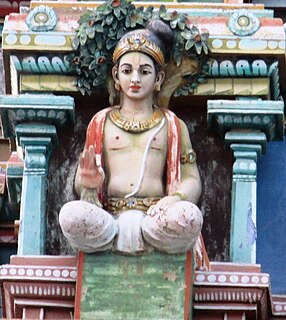
Nammazhwar is one of the twelve alwar saints of Tamil Nadu, India, who are known for their affiliation to the Vaishnava tradition of Hinduism. The verses of alwars are compiled as Nalayira Divya Prabandham and the 108 temples are classified as Divya Desam. Nammalwar is considered the fifth in the line of the twelve alwars. He is highly regarded as a great mystic of the Vaishnava tradition. He is also considered the greatest among the twelve alwars and his contributions amount to 1352 among the 4000 stanzas in the Nalayira Divya Prabandam.

The azhwars also spelt as alwars or Alvar, were Tamil poet-saints of South India who espoused bhakti (devotion) to the Hindu god Vishnu or his avatar Krishna in their songs of longing, ecstasy and service. They are venerated especially in Vaishnavism, which regards Vishnu or Krishna as the Supreme Being.

A Divya Desam or Vaishnava Divya Desam is one of the 108 Vishnu temples that are mentioned in the works of the Alvars (saints). ”Divya” means “divine” and “Desam” indicates “place or abode” (temple). Of the 108 temples, 105 are in India, one is in Nepal, and last two are believed to be outside the Earthly realms. In India, they are spread over states of Tamil Nadu (85), Kerala (11), Andhra Pradesh (2), Gujarat (1), Uttar Pradesh (4), Uttarakhand (3). Muktinath, Saligramam is the only Divya Desam in Nepal. The Divya Desams are revered by the 12 Alvars in the Divya Prabandha, a collection of 4,000 Tamil verses. Divya Desams follow Thenkalai or Vadakalai modes of worship.

Poigai Azhwar is one of the twelve azhwar saints of South India, who are known for their affiliation to Vaishnava tradition of Hinduism. The verses of azhwars are compiled as Nalayira Divya Prabandham and the 108 temples revered are classified as Divya desam. Poigai is one of the three principal azhwars, with the other two being Bhoothathazhwar and Peyazhwar, collectively called Muthalamazhwargal who are known to be born out of divinity. Poigai composed hundred verses that are classified as Muthal Tiruvandadhi and his composition is set in the Andhadhi style in which the ending syllable is the starting one for the next verse.
Pey Azhwar is one of the twelve azhwar saints of South India, who are known for their affiliation to Vaishnava tradition of Hinduism. The verses of azhwars are compiled as Nalayira Divya Prabandham and the 108 temples revered are classified as Divya desam. Pey Azhwar is considered third in the list of the three principal azhwars, with the other two being Poigai Azhwar and Bhoothathazhwar, collectively called Muthalamazhwargal who are known to be born out of divinity. Pey Azhwar composed hundred verses that are classified as Moondram Tiruvandadhi and his composition is set in the Andhadhi style in which the ending syllable is the starting one for the next verse.
Thirumazhisai Alvar is a Tamil saint revered in the Srivaishnavism school of south India, in Tondai Nadu. He was born in 4203 BCE. The legend of this saint devotees of Srivaishnavism believe that he was the incarnation of Vishnu's disc, Sudarshana. He is believed to have been born at Jagannatha Perumal temple, Tirumazhisai by divine grace.
Periyalvar, also known as Vishnucitta was one of the twelve alvar saints of South India, who are known for their affiliation to Vaishnava tradition of Hinduism. His name is also transliterated as Periyalwar, Periyazhwar, or Periyazhvar
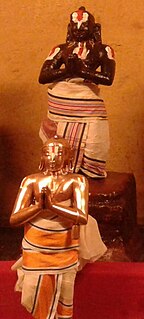
Thondaradippodi Alvar or Vipra Narayana is one of the twelve azhwar saints of South India, who are known for their affiliation to Vaishnava tradition of Hinduism. The verses of azhwars are compiled as Nalayira Divya Prabandham and the 108 temples revered are classified as Divya desam. Thondaripodi is considered the tenth in the line of the twelve azhwars.
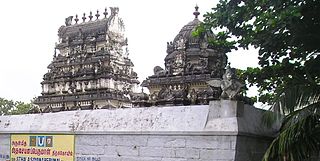
Sthalasayana Perumal Temple is at Mahabalipuram. Constructed in the Dravidian style of architecture, the temple is glorified in the Divya Prabandha, the early medieval Tamil canon of the Azhwar saints from the 6th–9th centuries AD. It is one of the 108 Divyadesam dedicated to Vishnu, who is worshipped as Sthalasayana Perumal and his consort Lakshmi as Nilamangai Thayar. The temple is believed to have been built by Pallavas, with later contributions from Medieval Cholas, Vijayanagar kings and Madurai Nayaks.

Ashtabujakaram or Ashtabuja Perumal Temple located in Kanchipuram in the South Indian state of Tamil Nadu, is dedicated to the Hindu god Vishnu. Constructed in the Dravidian style of architecture, the temple is glorified in the Divya Prabandha, the early medieval Tamil canon of the Azhwar saints from the 6th–9th centuries AD. It is one of the 108 Divyadesam dedicated to Vishnu, who is worshipped as Ashta Bhuja Perumal and his consort Lakshmi as Alamelumangai.

Tiruvekkaa Temple or Yathothkari Perumal Temple is a Hindu temple located in Kanchipuram in the South Indian state of Tamil Nadu and dedicated to the Hindu god Vishnu. Constructed in the Dravidian style of architecture, the temple is glorified in the Divya Prabandha, the early medieval Tamil canon of the Azhwar saints from the 6th–9th centuries AD. It is one of the 108 Divyadesam dedicated to Vishnu, who is worshipped as Yathothkari Perumal and his consort Lakshmi as Komalavalli.

Tiruththanka, or Tooppul located in Kanchipuram in the South Indian state of Tamil Nadu, is dedicated to the Hindu god Vishnu. Constructed in the Dravidian style of architecture, the temple is glorified in the Divya Prabandha, the early medieval Tamil canon of the Azhwar saints from the 6th–9th centuries AD. It is one of the 108 Divyadesam dedicated to Vishnu, who is worshipped as Deepa Prakasar and his consort Lakshmi as Maragathavailli.
Thiruppaan Alvar or Thirupaanazhwar is one of the twelve azhwar saints of South India, who are known for their affiliation to Vaishnava tradition of Hinduism. The verses of azhwars are compiled as Nalayira Divya Prabandham and the 108 temples revered are classified as Divya desam. Thirupaanazhwar is considered the eleventh in the line of the twelve azhwars.
The Alvars during the early medieval period of Tamil history worshipped Vishnu and his avatars through their hymns. This collection of their hymns is known as Divya Prabhandham. Mangalasasanam means "praying that the holy shrines be happy all the time". The Srivaishnava shrines that were sung about by the Alvars are called Divya Desams. The divyadesams that have the most number of pasurams sung upon them are Srirangam (247), Thirumala (202), Thirumaliruncholai and Thirukannapuram.

Thiru Anbil, or Sundararaja Perumal Temple, in Anbil, a village in the outskirts of Tiruchirappalli in the South Indian state of Tamil Nadu, is dedicated to the Hindu god Vishnu. Constructed in the Dravidian style of architecture, the temple is glorified in the Divya Prabandha, the early medieval Tamil canon of the Azhwar saints from the 6th–9th centuries AD. It is one of the 108 Divyadesam dedicated to Vishnu, who is worshipped as Sundararajan and his consort Lakshmi as Sundaravalli.
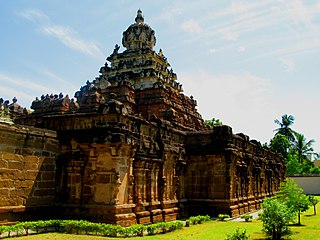
Thiru Parameswara Vinnagaram or Vaikunta Perumal Temple is a temple dedicated to Vishnu, located in Kanchipuram in the South Indian state of Tamil Nadu. Constructed in the Dravidian style of architecture, the temple is glorified in the Divya Prabandha, the early medieval Tamil canon of the Azhwar saints from the 6th–9th centuries AD. It is one among the 108 Divyadesam dedicated to Vishnu, who is worshipped as Vaikuntanathan and his consort Lakshmi as Sri Vaikundavalli. The temple is considered the second oldest extant temples in Kanchipuram after the Kailasanthar temple.
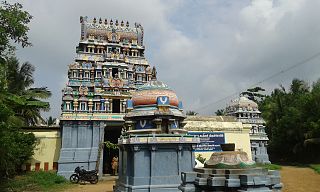
Thiruarimeya Vinnagaram or Kudamudakoothan Perumal Temple is dedicated to Hindu god Vishnu located in Thirunangur, a village in the outskirts of Sirkazhi in the South Indian state of Tamil Nadu. Constructed in the Dravidian style of architecture, the temple is glorified in the Divya Prabandha, the early medieval Tamil canon of the Azhwar saints from the 6th–9th centuries AD. It is one of the 108 Divyadesam dedicated to Vishnu, who is worshipped as Kudamudakoothan and his consort Lakshmi as Amirtagadavalli.

Ulagalantha Perumal Temple or Trivikrama Temple is a Hindu temple dedicated to Vishnu located in Tirukkoyilur, Tamil Nadu, India. Constructed in the South Indian style of architecture, the temple is glorified in the Divya Prabandha, the early medieval Tamil canon of the Azhwar saints from the 6th–9th centuries AD. It is one of the 108 Divyadesam dedicated to Vishnu, who is worshipped as Ulagalantha Perumal and his consort Lakshmi as Poongothai. The temple is believed to have been built by the Medieval Cholas, with later contributions from Vijayanagar kings and Madurai Nayaks. The temple covers an area of 5 acres (20,000 m2) and has a temple tower that is the third tallest in Tamil Nadu, measuring 192 ft (59 m) in height.

Azhwarthirunagari Permual Temple is one of the Nava Tirupathi, in Azhwar Thirunagari, a town in Thoothukudi district in the South Indian state of Tamil Nadu, is dedicated to the Hindu god Vishnu. It is located 26 km from Tirunelveli. Constructed in the Dravidian style of architecture, the temple is glorified in the Divya Prabandha, the early medieval Tamil canon of the Azhwar saints from the 6th–9th centuries AD. It is one of the 108 Divyadesam dedicated to Vishnu, who is worshipped as Adinathar and his consort Lakshmi as Athinathanayagi. The temple is also classified as a Navatirupathi, the nine temples revered by Nammazhwar located in the banks of Tamiraparani river. The temple is the most prominent among the nine Navatirupathi temples. The temple is one of the Navagraha temples in Vaishnavism, associated with Jupiter, the Guru.
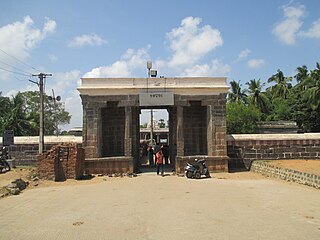
Nithyakalayana Perumal temple in Thiruvidandai, a village in Chennai, Kanchipuram district of the South Indian state of Tamil Nadu, is dedicated to Varaha, the boar avatar of the Hindu god Vishnu. Constructed in the Dravidian style of architecture, the temple is glorified in the Divya Prabandha, the early medieval Tamil canon of the Azhwar saints from the 6th–9th centuries AD. It is one of the 108 Divyadesam dedicated to Vishnu, who is worshipped as Nithyakalayana Perumal (Varaha) and his consort Lakshmi as Komalavalli Thayar. The original structure of the temple was built by the Pallavas during the 7th century CE, with later additions from the Cholas during the 11th century.


























